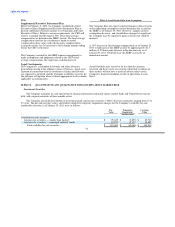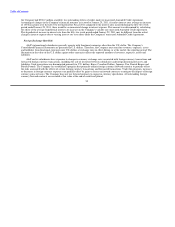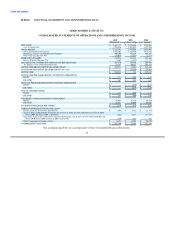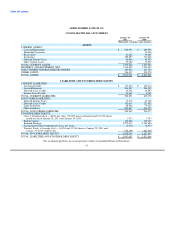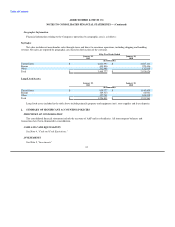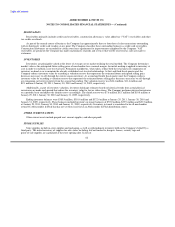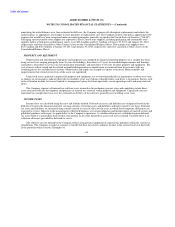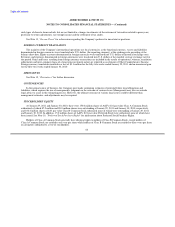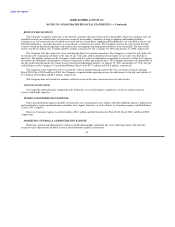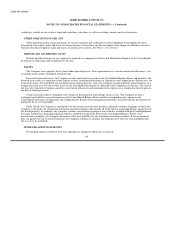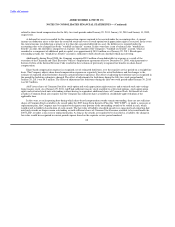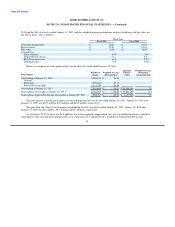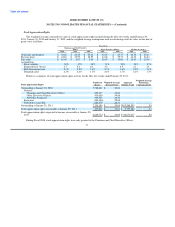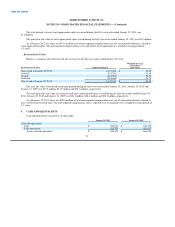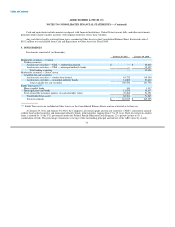Abercrombie & Fitch 2010 Annual Report Download - page 66
Download and view the complete annual report
Please find page 66 of the 2010 Abercrombie & Fitch annual report below. You can navigate through the pages in the report by either clicking on the pages listed below, or by using the keyword search tool below to find specific information within the annual report.
Table of Contents
ABERCROMBIE & FITCH CO.
NOTES TO CONSOLIDATED FINANCIAL STATEMENTS — (Continued)
amortizing the initial balances over their estimated useful lives, the Company expenses all subsequent replacements and adjusts the
initial balance, as appropriate, for changes in store quantities or replacement cost. The Company believes this policy approximates the
expense that would have been recognized under accounting principles generally accepted in the United States of America ("GAAP").
Packaging and consumable store supplies are expensed as used. Current store supplies, including packaging and consumable store
supplies held at a third-party replenishment center, were $20.6 million and $11.1 million at January 29, 2011 and January 30, 2010,
respectively, and were classified as Other Current Assets on the Consolidated Balance Sheets. Non-current store supplies were
$32.3 million and $32.4 million at January 29, 2011 and January 30, 2010, respectively, and were classified as Other Assets on the
Consolidated Balance Sheets.
PROPERTY AND EQUIPMENT
Depreciation and amortization of property and equipment are computed for financial reporting purposes on a straight-line basis,
using service lives ranging principally from 30 years for buildings; from three to 15 years for leasehold improvements and furniture
and fixtures; from three to seven years for information technology; and from three to 20 years for other property and equipment. The
cost of assets sold or retired and the related accumulated depreciation or amortization are removed from the accounts with any
resulting gain or loss included in net income. Maintenance and repairs are charged to expense as incurred. Major remodels and
improvements that extend service lives of the assets are capitalized.
Long-lived assets, primarily comprised of property and equipment, are reviewed periodically for impairment or whenever events
or changes in circumstances indicate that full recoverability of net asset balances through future cash flows is in question. Factors used
in the evaluation include, but are not limited to, management's plans for future operations, recent operating results and projected cash
flows.
The Company expenses all internal-use software costs incurred in the preliminary project stage and capitalizes certain direct
costs associated with the development and purchase of internal-use software within property and equipment. Capitalized costs are
amortized on a straight-line basis over the estimated useful lives of the software, generally not exceeding seven years.
INCOME TAXES
Income taxes are calculated using the asset and liability method. Deferred tax assets and liabilities are recognized based on the
difference between the financial statement carrying amounts of existing assets and liabilities and their respective tax bases. Deferred
tax assets and liabilities are measured using current enacted tax rates in effect for the years in which those temporary differences are
expected to reverse. Inherent in the measurement of deferred balances are certain judgments and interpretations of enacted tax law and
published guidance with respect to applicability to the Company's operations. A valuation allowance is established against deferred
tax assets when it is more likely than not that some portion or all of the deferred tax assets will not be realized. Currently there is no
valuation allowance provided for deferred tax assets.
The effective tax rate utilized by the Company reflects management's judgment of expected tax liabilities within the various tax
jurisdictions. The Company records tax expense or benefit that does not relate to ordinary income in the current fiscal year discretely
in the period in which it occurs. Examples of
63


